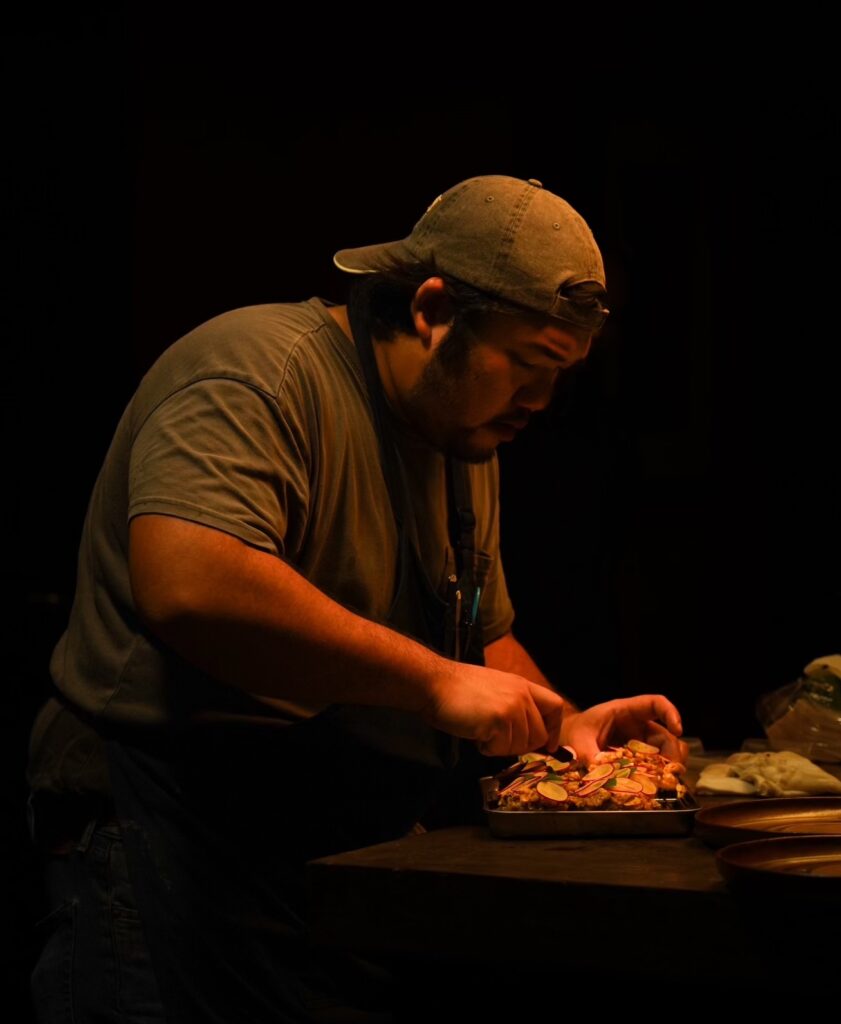At Pagtitipon, an 8-course natural wine-paired dinner, Luis used overlooked or obscure Filipino ingredients that he has always loved.
I first met kusinero Luis Locsin online. We were on a Zoom call to discuss a pop-up wine dinner we were working on together. He was bringing in his food expertise to help pair the wines and I was going to do the “wine-splaining” to diners.



What struck me most about him was how comfortable he was talking about both food and wine. He was not the chef working the dinner but he had a very clear idea of what wines would go with which course.
Having worked several wine dinners myself, where chefs were more than happy to turn over all the wine decisions up to me, it was quite refreshing to meet someone who could “talk wine” with so much ease. This was someone who truly understood flavor, I thought to myself.
Locsin’s plans involve long-term sustainability and self sufficiency in terms of food systems—while soaking up the sun on the beach.
But more than his natural flair for food and wine pairings, it was his relaxed demeanor and unassuming air that stuck with me. It was obvious he knew his way around the kitchen but not once did he mention his culinary training.
Luis went to the Culinary Institute of America (CIA), by the way, and finished with a degree in Culinary Science. But to me, he was just this teddy bear of a guy who loves to cook good food and share it with people who love to eat. A true reflection of how he was raised.



Starting young with food and wine
“My family has always loved to eat. Both my grandmothers loved to watch me eat when I was young. So they fed me their favorite things, from oysters to caviar and lobster, pancit molo, callos, and cocido. All that I ate and experienced from a very young age absolutely shaped the way I cook and my particular food journey,” Luis shares.
And while most people’s midnight snacking adventures end up with pizza, Luis’ kitchen took on a more creative turn. At 12 years old, whenever he would come home to Manila for the holidays from boarding school in the States, he would be jetlagged and hungry. But he didn’t want junk food. He wanted real, hot food.
So he started by making himself simple stuff like scrambled eggs and fried rice. Later on, these humble meals turned into full blown gourmet feasts. “Eventually, my solo kitchen adventures at 2 am started to morph into things like eggs benedict, gnocchi, and even a beef Wellington once! Looking back now, those times in the kitchen by myself really were the catalyst for everything that I do now,” he explains.



Going pro
Naturally, cooking turned into a passion for Luis. His first “professional” experience was in the kitchen of a Zubochon branch in Cebu during the summer of his junior year in high school. That month-long stint clearly mapped out what the future would be for the young, aspiring cook.
“When I started to think about college, I realized that the only place I really wanted to go to was the Culinary Institute of America (CIA),” Luis shares. To prepare himself for culinary school, he spent 6 months in the kitchen of Antonio’s Tagaytay. After finishing his studies at CIA, he went on to work for the Jean Georges restaurant group as a line cook in New York. And then Covid hit, so Luis went back home.
New York’s loss was definitely Manila’s gain.
“I did a long stage at my favorite restaurant in the Philippines, Metiz. This obviously opened my eyes to all sorts of Filipino ingredients and tastes,” enthuses Luis.
It was in Metiz, too, where Luis met and worked with one of his biggest food influences, chef Stephane Duhesme. The chef is known for his focus on flavor building—something that Luis is trying to emulate with his own cooking. Cooking that I had the privilege to try by way of “Pagtitipon,” an 8-course wine-paired dinner championing local ingredients at La Vie En Rose in the heart of Poblacion.



Pairing local food with natural wine
For this dinner, the wines used were all natural, for a reason. “It was always going to be a natural wine pairing. Not only because (Super) Natural was going to be a collaborator, but because I knew I wanted to work with Filipino ingredients and flavors. For me, natural wine and the sour Filipino palate go hand in hand. The inherent acidity in most natural wines is able to hold its own to the acidity of our food, which leads to a balanced pairing,” Luis states.
And what a thoughtful pairing it was. With kusinero Luis at the helm, homemade fruit vinegars such as strawberry, duhat and even mangosteen were incorporated into each dish. There was no need to step on the brakes with acidity because the wines paired with every course could definitely stand up to even the sourest of sauces and dressings.
A personal favorite was the puso ng saging soup with gingers and tinapa cream paired with a Sancerre by Sebastien Riffault. Cream, acid, and smoke all melded beautifully on my tongue washed down with the refreshing white wine. I still dream of this pairing today.
When asked if he would ever pair his meals with conventional wine, Locsin says, “Absolutely. I do think that this particular menu will always be best with natural wine because I designed it that way. But most if not all the dishes would work with conventional wines. I think the soup with a Condrieu AOC, the sayote salad with a crisp dry Furmint from Tokaji, or the fish with a Chambolle-Musigny from Côte de Nuits would all work well.”



Looking ahead
With Pagtitipon done, Luis is looking forward to creating more dining experiences focusing on overlooked Filipino ingredients that he loves. Expect things like sayote tops, puso ng saging and bangus belly as well as ginger torch, green amaranth and kalachuchi to feature highly in his future menus.
“The possibilities are endless when we start to look inward to our humble and wild ingredients that we only cook a certain way, (malunggay doesn’t only have to be in tinola) and treat them with respect using unexpected techniques,” Luis emphasizes.
Luis also wants to open up his own beachside restaurant in Puerto Galera, Mindoro, a place that he has been visiting with his family since the 1980s. A casual dining restaurant and bar, using produce from its own organic farm (and even foraged ingredients!), where food waste is almost non-existent.
“Food waste will go back into the soil in the form of compost. Fruit and vegetable trim will be used and upcycled in the form of homemade vinegars, kombuchas, and bitters for the bar. They will also be available for customers to buy at its own general store,” Locsin says.
There is so much more in the pipeline for this kusinero in the next five years. His plans involve long-term sustainability and self sufficiency in food systems while giving back to the community. All while sporting a “hard sunglasses tan line on the beach or on a boat with a fishing rod in my hand and my restaurant on the horizon,” Luis shares.
Not a bad plan at all, Luis. I’m completely on board.





